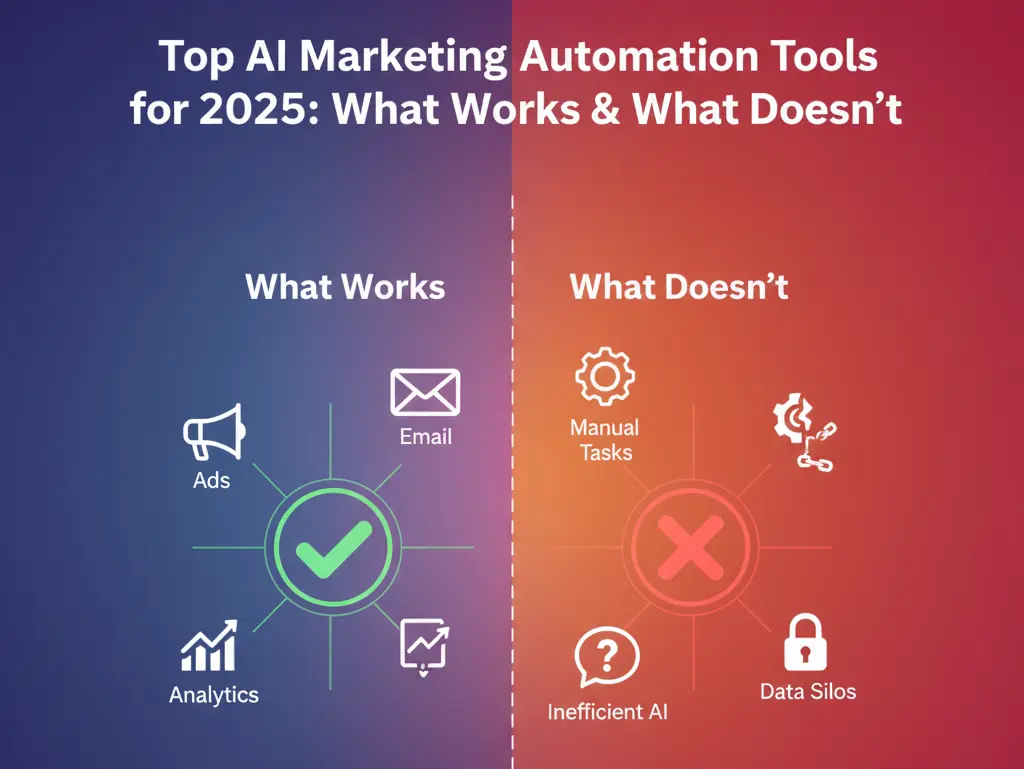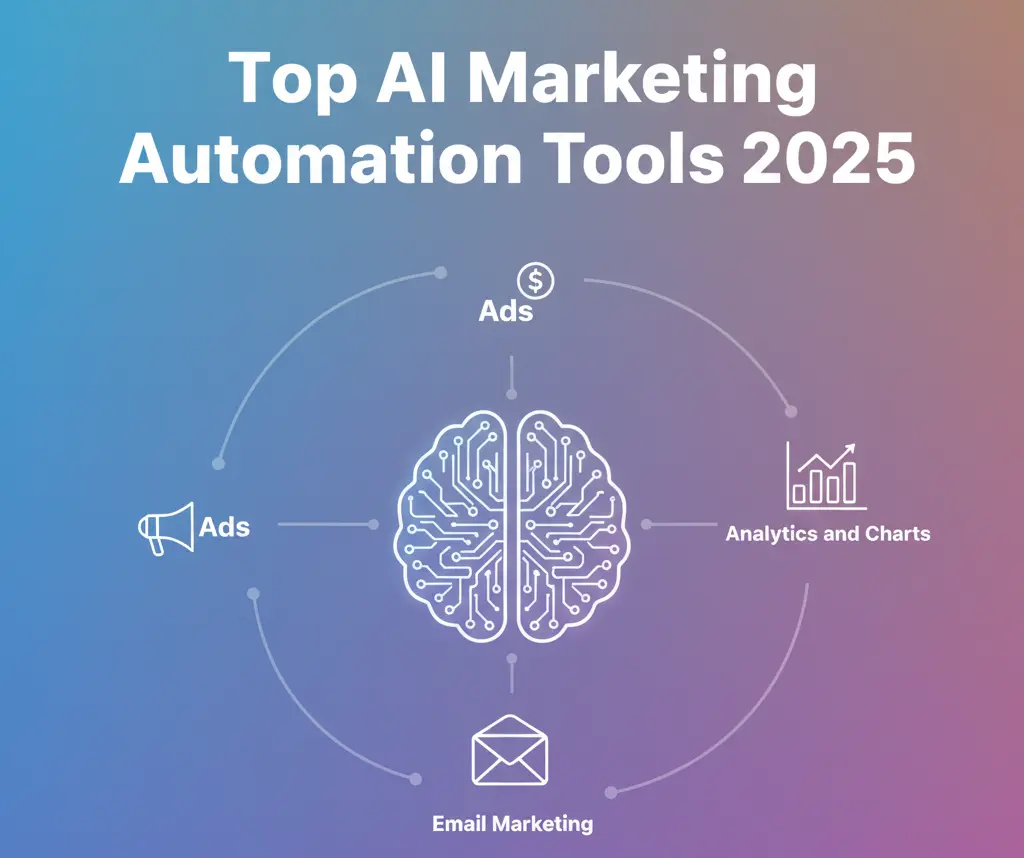
Introduction – The AI Takeover of Modern Marketing
If 2023 was the year marketers tested AI, 2025 is the year they depend on it.
From copywriting to campaign optimization, AI tools have evolved from “nice to have” gadgets to mission-critical engines that run entire marketing operations.
But with so many AI platforms launching every month, it’s easy to waste hours testing tools that overpromise and underdeliver.
So, I’ve analyzed the top AI marketing automation tools of 2025 — and uncovered what actually works, what’s hype, and what to skip.
Why AI Marketing Tools Are Essential in 2025
The digital marketing landscape is faster than ever — audience behavior shifts in days, not months.
AI bridges that gap by automating:
- Ad creative optimization
- Customer segmentation
- Predictive analytics
- Automated reporting and campaign scaling
According to HubSpot’s 2025 Marketing Report, marketers using AI automation experience a 38% increase in campaign ROI and save up to 12 hours weekly on repetitive tasks.
So, whether you’re running paid ads, building funnels, or writing blogs — these tools can 10x your productivity.

The Top 7 AI Marketing Automation Tools for 2025
1. HubSpot AI – The Smart CRM for Marketers
HubSpot’s new AI suite goes beyond CRM automation.
It now includes AI-powered lead scoring, email sequence generation, and predictive analytics that identify conversion-ready users.
Why It Works:
- Natively integrates sales, marketing, and support
- AI predicts the best time to engage leads
- Simple UI, perfect for SMBs
Where It Falls Short:
- Expensive for smaller teams
- Limited customization in the free plan
🔹 Best for: Marketing teams needing full-funnel automation with CRM integration
2. Jasper – AI Copywriting That Converts
Jasper is no longer just a content tool — it’s an AI writing assistant with tone control, brand voice memory, and SEO integrations.
Why It Works:
- 50+ templates for ads, blogs, and social media
- Integrates with SurferSEO & Grammarly
- Learns your brand tone over time
Where It Falls Short:
- Can produce generic outputs if prompts are vague
- Monthly plan starts at $39+
🔹 Best for: Agencies, content marketers, and paid media teams
3. ChatGPT + Zapier – The Dynamic Duo for Workflow Automation
ChatGPT handles ideation and writing; Zapier automates distribution.
Together, they become a no-code automation powerhouse for marketers.
Example Workflow:
- ChatGPT generates ad headlines → Zapier sends them to Google Sheets → posts to Meta Ads Manager drafts
Why It Works:
- Saves hours of manual coordination
- Great for small teams with no dev resources
Where It Falls Short:
- Requires clear prompt structure
- Zapier costs can add up at scale
🔹 Best for: Marketers building efficient, automated workflows
4. Copy.ai – For Social Content and Ad Variations
If you run paid campaigns, Copy.ai’s AI Ad Generator is a lifesaver.
It produces high-converting ad variations and CTA testing suggestions instantly.
Why It Works:
- Great for Meta, TikTok, and LinkedIn ad copy
- Generates multiple CTAs in one click
- Built-in analytics suggestions
Where It Falls Short:
- Doesn’t integrate deeply with ad dashboards
- Copy quality sometimes too “salesy”
🔹 Best for: Paid social and content teams
5. SurferSEO + ChatGPT – SEO Meets AI Content Strategy
This combo is dominating SEO workflows.
SurferSEO provides data-driven optimization, while ChatGPT writes with that guidance.
Why It Works:
- Generates content outlines based on search intent
- Optimizes for keyword density and readability
- Reduces research time drastically
Where It Falls Short:
- Requires manual fact-checking
- Subscription costs can pile up
🔹 Best for: SEO specialists and content strategists
6. Huberman (AI Ads Optimization) – Real-Time Media Buying Intelligence
Huberman is a new player in ad automation that uses machine learning to adjust bids and creatives based on live performance.
Why It Works:
- Real-time campaign optimization
- Works across Meta, Google, and TikTok
- Learns from multi-channel data
Where It Falls Short:
- Still early-stage; lacks transparency in algorithm
- Needs strong data input to work efficiently
🔹 Best for: Programmatic and performance marketers
7. Notion AI – Managing Marketing Ideas Smarter
Notion’s AI upgrade lets marketers summarize campaign notes, generate to-do lists, and write mini briefs automatically.
Why It Works:
- Great for solo marketers or small teams
- Organizes campaign ideas and scripts in one hub
- Integrates with Slack, ClickUp, and Google Drive
Where It Falls Short:
- Not a “pure” marketing tool — more for organization
- Needs structured workflows to shine
🔹 Best for: Freelancers and strategy teams

What Actually Works (And What Doesn’t)
| Works Well | Doesn’t Work So Well |
|---|---|
| AI + Human Collaboration | Full automation without supervision |
| Workflow automation (Zapier, HubSpot AI) | Overreliance on generic AI writing |
| SEO + AI Integration (Surfer + ChatGPT) | Ignoring prompt optimization |
| Ad testing automation | “One-size-fits-all” templates |
The truth?
AI is powerful — but only when you train it to think like you.
The best results come from clear prompts + manual refinement + strategic oversight.
Future of AI Marketing – The Human + Machine Synergy
By 2026, most marketing teams will operate in a hybrid environment — humans defining strategy, AI executing at scale.
Imagine this workflow:
- You design a campaign concept → AI builds variations → automation runs A/B tests → you analyze results.
That’s the new normal — creative marketers commanding intelligent assistants.
Final Thoughts – How to Integrate AI Without Losing Creativity
The secret to using AI effectively isn’t to outsource thinking — it’s to multiply it.
Start small:
- Use one AI tool for reporting
- Another for writing
- And one for campaign automation
Once they work in sync, you’ll achieve the sweet spot — creativity + efficiency.